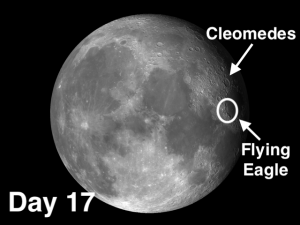 The week of August 27 – September 2 takes us from Day 16 to Day 22. This week we will highlight the crater Cleomedes, viewable on Monday night, and a feature unofficially called The Flying Eagle, viewable on Tuesday (you might also try for Monday night).
The week of August 27 – September 2 takes us from Day 16 to Day 22. This week we will highlight the crater Cleomedes, viewable on Monday night, and a feature unofficially called The Flying Eagle, viewable on Tuesday (you might also try for Monday night).
 Cleomedes: [NE/G15] Cleomedes is the first significant crater just north of Mare Crisium. It is a splendid crater, 80 miles in diameter, with terraced walls, rilles, and a small central mountain. There are also four craterlets and a Y-shaped rille on the northern half of the floor just east of the central mountain peak. Notice that the floor is unusually smooth. Because its southern rim touches one of the multi-rings encircling the Crisium basin, it is believed that lava rose up through Crisium fractures and smoothly covered the floor of Cleomedes. Under a low-angle Sun you might be able to detect that the rille cuts through a small dome on the northern section of the floor.
Cleomedes: [NE/G15] Cleomedes is the first significant crater just north of Mare Crisium. It is a splendid crater, 80 miles in diameter, with terraced walls, rilles, and a small central mountain. There are also four craterlets and a Y-shaped rille on the northern half of the floor just east of the central mountain peak. Notice that the floor is unusually smooth. Because its southern rim touches one of the multi-rings encircling the Crisium basin, it is believed that lava rose up through Crisium fractures and smoothly covered the floor of Cleomedes. Under a low-angle Sun you might be able to detect that the rille cuts through a small dome on the northern section of the floor.
 The Flying Eagle: [NE/H15; L=52°E] As the lava cooled following the impact that created Mare Crisium, a series of wrinkle ridges, known as Dorsum Oppel, formed along the entire western edge and give the impression of waves lapping on the shore. The flowing lava partially filled the pre-existing craters Yerkes and Lick [H15], turning them into ghost craters. There is also a more substantial ridge that connects the flooded crater Yerkes with the smaller Yerkes E, 15 miles to its northwest (unnamed on the Field Map). Under a low Sun (when the terminator is around 52° – 55°) this ridge looks remarkably like the silhouette of a bird in flight and has been nicknamed the Flying Eagle.
The Flying Eagle: [NE/H15; L=52°E] As the lava cooled following the impact that created Mare Crisium, a series of wrinkle ridges, known as Dorsum Oppel, formed along the entire western edge and give the impression of waves lapping on the shore. The flowing lava partially filled the pre-existing craters Yerkes and Lick [H15], turning them into ghost craters. There is also a more substantial ridge that connects the flooded crater Yerkes with the smaller Yerkes E, 15 miles to its northwest (unnamed on the Field Map). Under a low Sun (when the terminator is around 52° – 55°) this ridge looks remarkably like the silhouette of a bird in flight and has been nicknamed the Flying Eagle.
======================
It is highly recommended that you get a copy of Sky and Telescope’s Field Map of the Moon, the very finest Moon map available for use at the telescope. It is available for $10.95 at www.skyandtelescope.com and on Amazon. All features mentioned in this blog will be keyed to the grid on the Field Map and will look like this: Plato: [NW/D9]
Credits:
Courtesy of Gray Photography of Corpus Christi, Texas
Lunar photos: NASA / USGS / BMDO / LROC / ASU / DLR / LOLA / Moon Globe. Used by permission
- Rupes Cauchy: A Best Known Fault on the Moon - July 22, 2024
- Moon Crater Schickard – Crater Floor has Stripes - July 15, 2024
- Moon Craters Langrenus and Vandelinus - July 8, 2024